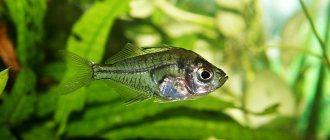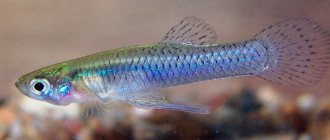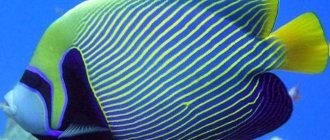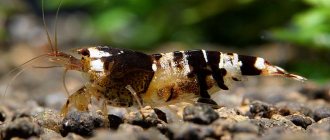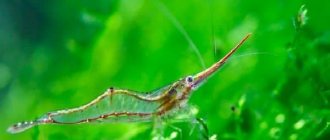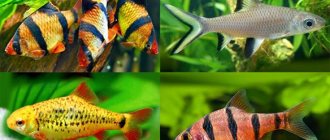Denison Barbus (Puntius denisonii) is a beautifully colored, relatively large and very active aquarium fish. Ideal for keeping in large aquariums over 400 liters. Fish are not aggressive, indifferent to ornamental plants, have excellent health and are not picky in their diet.
The homeland of the Denison barb is the fresh waters of tropical India. More precisely, these are several rivers flowing in the southwestern part of the country, through the states of Kerala and Karnataka. These places represent a real biological treasury, one of the world's top ten territories characterized by species diversity; about 300 species of fish alone live here, a significant part of which are objects of ornamental fish farming.
Gender characteristics and external characteristics
Barbus denisoni has a lanceolate body of golden-silver color, and a black line stretches through the body . On this stripe there is a bright red line and stretches all the way to the dorsal fin. It, in turn, is distinguished by its olive color, and on the tail there is a V-shaped cutout with transverse lines of black and yellow color. The anterior rays on the dorsal fin are distinguished by a red tint, while the other fins are transparent. In a fish-friendly habitat, barbs grow up to 15 cm and live up to eight years. Barbus denison prefers a gregarious lifestyle. Males are practically no different from females. Females have a slightly rounder abdomen, which is most noticeable when they are pregnant.
HABITAT IN NATURE
Barbus denisonii was first described in 1865 and is native to South India (Kerala and Karnatka states). They live in large flocks in streams, rivers, and ponds, choosing places with a lot of plants and a rocky bottom. The water in their habitats is usually rich in oxygen.
Like many other fish, the denison barb changed its scientific name several times during its discovery; it is now called Puntius denisonii. And previously it was: Barbus denisonii, Barbus denisonii, Crossocheilus denisonii, and Labeo denisonii. And in his homeland, in India, his name is: Miss Kerala.
Unfortunately, this barb can be cited as an example of a situation when there is suddenly a lot of interest in the market for a fish. After it was recognized as one of the best fish at an international aquarium exhibition, its demand increased sharply.
Within a decade, more than half of the denison barb population had been exported from India. As a result, there is a general drop in the number of fish in nature, due to almost industrial fishing. Industrial water pollution and the settlement of fish habitats also played a role. The Government of India has taken measures to ban the fishing of the barb during certain periods; they also began to breed it on farms in Southeast Asia and Europe, but it is still in the Red Book as a fish that is under threat.
Description
A long and torpedo-shaped body designed for rapid swimming. The body is silvery with a black line that runs from the nose to the tail of the fish. And contrasting with the black line is a bright red that goes above it, starting from the nose, but ending in the middle of the body.
The dorsal fin is also bright red along the edge, and the caudal fin has yellow and black stripes. In mature individuals, a greenish stripe appears on the head.
They grow up to 11 cm, usually somewhat less. Life expectancy is about 4-5 years.
Upon reaching adult size, the fish develops a pair of greenish whiskers on its lips, with which it searches for food.
In recent years, a gold color variant has appeared, which has a red stripe but lacks a black one, however, this is still a very rare color.
Content
Aquarium. The size of Miss Kerala individuals is rather large, and they live only in a flock, so the volume of the aquarium must be large. For example, it is recommended to keep a group of 7–12 copies in a 200-liter “jar”, and it is desirable that it be long rectangular.
Having space for rapid movement is what is needed for a flock of “red comets” that prefer to be in the middle and lower layers of the water mass.
Vegetation . For the same reason, plants are planted along the edges of the aquarium landscape; they must have strong roots to successfully resist attempts to dig up the soil. Vallisneria, hornwort, cryptocoryne, and echinodorus have proven themselves well.
Bottom organization . Small pebbles or coarse river sand of natural origin are ideal for soil. An artificial substrate is also suitable, but you should make sure that it is neutral in terms of chemical composition. Also, driftwood, small grottoes and caves can be installed along the edges where fish can hide.
Water parameters . There is an opinion that puntius denison requires some special treatment, and the level of its maintenance is considered complex. Based on the required water parameters, there is nothing complicated:
- temperature range - from +20°C to +25°C,
- pH balance - close to neutral (6.5–7.5 units),
- hardness - from 8 to 13 degrees.
Equipment . To create conditions similar to natural ones, aeration must be intense, and the filter must have a powerful pump for the most effective cleaning and creation of water flow. Fish cannot tolerate excess nitrates and nitrites at all, therefore, in addition to biological purification of the aquatic environment, weekly changes are necessary: 30% of the total volume.
It should be emphasized that the practice of keeping it is still very poorly developed, and there is an explanation for this: the insufficient prevalence of the species in the domestic aquarium hobby.
Reviews
Aquarists who have purchased Denison fish speak positively about the species. The fish amazes with its beauty and active behavior. The only downside is the rather high price of the fish, especially if you buy a school at once.
Compatibility
In general, the Denison barb is a peaceful fish, but can be aggressive towards small fish and should be kept with fish of equal or larger size. Typically, reports of aggressive behavior concern situations where one or two fish are kept in an aquarium. Since denison is a fairly expensive fish, they usually buy a couple. But! It needs to be kept in a flock of 6-7 individuals or more. It is in a school that the aggressiveness and stress of fish decreases. Considering that it is quite large, an aquarium is needed for such a flock from 55 liters. Good neighbors for Denisoni will be: Sumatran barb, Congo, diamond tetra, thornets, or various catfish - cockroaches, corydoras.
GENDER DIFFERENCES
There are no obvious differences between males and females. However, mature females are somewhat larger, with a fuller belly, and sometimes less brightly colored than the male.
How to breed barbs
Under artificial conditions, the reproduction of red-lined barbs is a rather complex process that requires effort. In order to obtain offspring, it is necessary to initially prepare a separate tank for spawning, designed for at least 200 liters of liquid. The bottom of the tank will need to be covered with moss. For successful breeding of denison barbs, it is very important to maintain the temperature at a level of +26 to +28°C. Acidity should be reduced by additionally adding peat to the water.
Given the schooling lifestyle, the entire family of denison barbs is sent to the spawning grounds, among which pairs are already formed independently. After the eggs are laid, all adults should be immediately moved to a community aquarium, since due to the complete lack of parental instincts, representatives of this species can consume their own eggs.
The fry are fed with ciliates and “live dust”, taking care to maintain optimal temperature conditions and parameters of the aquatic environment. Gradually, as the babies grow up, they are transferred to larger feeds and water indicators change, identical to those for adults. When reaching sexual maturity, the offspring of the Denisoni barb can be moved to a community aquarium.
Reproduction
It is produced in special nurseries. According to some information, it is stimulated through hormonal injections. This is why amateur home breeding is unlikely to work.
At the same time, in a number of sources you can find at least two cases of aquarium propagation.
- The first was in Germany, when spawning occurred in a school of 15 individuals by gradually reducing acidity. Hundreds of tiny eggs were laid on thickets of Java moss.
- The second known case was observed in the aquarium of an English zoo. The institution's staff considers this spawning incident to be accidental.
A beautiful, bright, fast and peaceful ornamental fish, the Denisoni barb is not yet so often found in domestic aquariums. One can only hope that over time the “red torpedo” will take the place it undoubtedly deserves.
Feeding
Denison barbs eat worms, shrimp, meat, fish flakes and some vegetation. Denisoni is an omnivore and consumes many different foods. For optimal health, they should be fed a variety of foods, including meat, as well as plants.
Live foods will be readily accepted, including bloodworms, daphnia, cyclops and shrimp. Seaweed, spirulina and even fresh vegetables will also be appropriate.
Nutrition
Sahyadria denisonii is an omnivorous species of cyprinid. In captivity, they happily eat daphnia and brine shrimp, bloodworms and barkworm, and finely chopped zucchini and cucumbers, spinach and lettuce can be given as plant food.
By the way, there is another way of feeding lettuce: the leaves are washed well, then scalded, lowered to the bottom of the aquarium, pressing the edge with a pebble. Decorative carp happily bite off the edges of the leaf.
Branded balanced food for medium and small carp, produced by Tetra, Sera, JBL and others, is also suitable.
CLOWN BARBUS: CONTENTS COMPATIBILITY BREEDING PHOTO FEEDING
BARBUS GREEN: CONTENT, COMPATIBILITY, BREEDING, FEEDING, PHOTO
TWO-POINT BARBUS: CONTENTS COMPATIBILITY PHOTO BREEDING DESCRIPTION
CHERRY BARBUS: CONTENTS BREEDING COMPATIBILITY FEEDING PHOTO DESCRIPTION.
BARBUS BUTTERFLY: CARE, COMPATIBILITY, BREEDING, FEEDING, PHOTO, DESCRIPTION
Breeding
Currently, limited spawning is observed in home aquariums. Domestic breeding has most often been accidental, and little is known about the conditions under which spawning occurred.
However, there have been successful commercial spawning operations that have used hormones to stimulate reproduction in this species. These successful attempts took place in soft acidic water, with eggs scattered on algae.
Who are Denisons compatible with?
Barbs are peace-loving fish; they show some aggression during the spawning period, as well as towards smaller species. Therefore, as neighbors it is worth choosing fish the size of barbs or a little larger, characterized by peaceful and friendly behavior. For example:
Sumatran barb
diamond tetra
Congo
thorns
catfish (tarakatums and corydoras)
Undesirable neighbors include guppies, neons, platies, fighting fish and swordtails.
Before adding new fish to the barbs, first keep them in quarantine, taking into account the weak immunity of the denison. You can put a few almond leaves in the sump for prevention.
What kind of environment does she thrive in?
The natural conditions for the existence of Denison differ:
- High mobility of water;
- Its almost artesian purity;
- Relatively low temperature;
- High oxygen saturation;
- The presence of free space that does not restrict movement.
Puntius denisonii does not like stagnation: it must constantly be in a whirlpool. On the one hand, she enjoys movement, on the other hand, the water is actively enriched with oxygen.
Possible problems
Denisoni barbs have a strong immune system and are naturally a very hardy fish, but under unfavorable conditions problems can occur.
Red-lined barbs may experience stress when:
- sudden change in water parameters;
- moving to another aquarium.
To avoid problems during relocation, it is recommended to give anti-stress medications to barbs, which are shy and sensitive fish by nature.
Red-lined barbs, active and playful, scurrying around in glittering flocks, are a wonderful decoration for any aquarium. But to keep such demanding fish, you need experience, patience and a sincere love for aquarium keeping.

